Method of improving vacuum quality in semiconductor processing chambers
a vacuum processing chamber and vacuum technology, applied in vacuum obtaining/maintenance, positive displacement liquid engines, lighting and heating apparatus, etc., can solve the problems of affecting the performance of thin films deposited by pvd and cvd processes, gaseous contaminants frequently, and significantly affecting the resistivity, grain structure, reflectivity, step coverage,
- Summary
- Abstract
- Description
- Claims
- Application Information
AI Technical Summary
Problems solved by technology
Method used
Image
Examples
Embodiment Construction
In the drawings described below, reference numerals are generally repeated where identical elements appear in more than one figure. Turning now to the drawings, and in particular to FIG. 1, therein is shown a pictorial view of an exemplary semiconductor vacuum processing chamber 10 that is connected to a pumping system 20 by means of a fluid line 30. A heating or degassing chamber 40 is provided for heating one or more conditioning wafers or workpieces 50. In accordance with the present invention, the heated conditioning wafer 50 is inserted into the processing chamber 10 to aid in the removal of gaseous phase contaminants therefrom and thus increase the vacuum level therein.
In accordance with the present invention, the processing chamber 10 may be a metal PVD chamber, a CVD chamber or virtually any other processing chamber wherein a vacuum is desirable to facilitate the processing. The fluid line 30 is a schematic representation of the connection between the processing chamber 10 a...
PUM
| Property | Measurement | Unit |
|---|---|---|
| thick | aaaaa | aaaaa |
| thickness | aaaaa | aaaaa |
| pressure | aaaaa | aaaaa |
Abstract
Description
Claims
Application Information
 Login to View More
Login to View More - R&D
- Intellectual Property
- Life Sciences
- Materials
- Tech Scout
- Unparalleled Data Quality
- Higher Quality Content
- 60% Fewer Hallucinations
Browse by: Latest US Patents, China's latest patents, Technical Efficacy Thesaurus, Application Domain, Technology Topic, Popular Technical Reports.
© 2025 PatSnap. All rights reserved.Legal|Privacy policy|Modern Slavery Act Transparency Statement|Sitemap|About US| Contact US: help@patsnap.com

